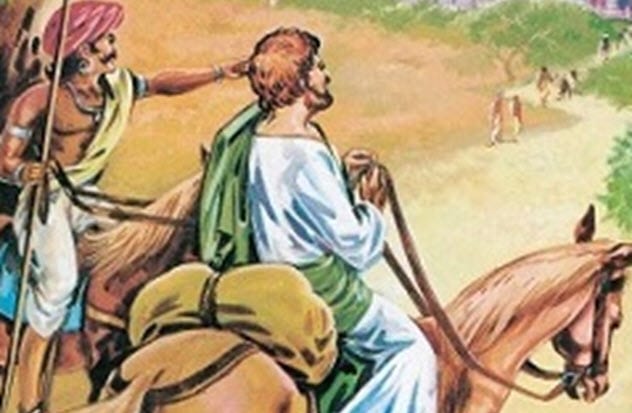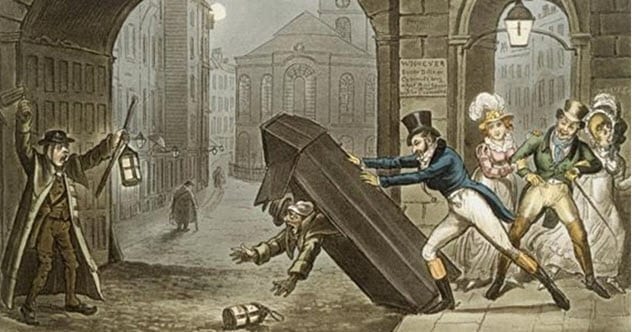 Technology
Technology  Technology
Technology  Animals
Animals 10 Popular Misconceptions about Dogs
 History
History 10 Unbelievably Badass Women from History
 Music
Music 10 Rock Musicians with Impressive College Degrees
 Misconceptions
Misconceptions 10 Totally Deceptive Marketing Tactics Exposed
 Movies and TV
Movies and TV 10 Amazing Facts About 10 of the Most Popular Television Shows
 History
History Top 10 Strange Ways Victorians Excercised
 Gaming
Gaming 10 Horror Games Where You Play as the Killer
 Our World
Our World Future Now: 10 Really Cool Things That Are about to Happen
 Miscellaneous
Miscellaneous Top 10 Still Existing Companies That Supported the Nazis
 Technology
Technology 10 Surprising Stories Made Possible by Cutting-Edge Technology
 Animals
Animals 10 Popular Misconceptions about Dogs
 History
History 10 Unbelievably Badass Women from History
Who's Behind Listverse?

Jamie Frater
Head Editor
Jamie founded Listverse due to an insatiable desire to share fascinating, obscure, and bizarre facts. He has been a guest speaker on numerous national radio and television stations and is a five time published author.
More About Us Music
Music 10 Rock Musicians with Impressive College Degrees
 Misconceptions
Misconceptions 10 Totally Deceptive Marketing Tactics Exposed
 Movies and TV
Movies and TV 10 Amazing Facts About 10 of the Most Popular Television Shows
 History
History Top 10 Strange Ways Victorians Excercised
 Gaming
Gaming 10 Horror Games Where You Play as the Killer
 Our World
Our World Future Now: 10 Really Cool Things That Are about to Happen
 Miscellaneous
Miscellaneous Top 10 Still Existing Companies That Supported the Nazis
10 Misconceptions About Medieval People
When we imagine what a typical medieval person would have looked like, what do we see? A scruffy peasant farmer. He has unkempt hair and a scratchy beard, brown clothes, and tatty shoes. Covered in dirt, he pulls a rickety cart behind him that could fall apart at any moment. And if you get too close, the smell of him might make you faint because medieval people only bathed once or twice a year, right?
We all have a pretty good idea of how a stereotypical medieval person looked, largely thanks to TV. Unfortunately, a lot of it is completely wrong. For one thing, razors have been around for thousands of years and wouldn’t have been hard to find, even for someone who didn’t have much money.
The Crusaders brought back soap from the Middle East (along with many other things), so after 1200, cleanliness was better than we might imagine. There are many misconceptions about medieval people. In this list, we’re setting the record straight on 10 of the most common ones.
10 They Only Drank Alcohol

It is often declared that medieval people never drank water because it was all dirty. To stay safe, they only drank alcohol, which was certain not to contain any diseases. It’s fairly obvious that this isn’t true, but it keeps being repeated across the Internet and even sometimes in documentaries.
Evidence to the contrary is scattered across the medieval world. Most castles, for instance, contain a well, which they used for drinking in addition to making stews and porridge, some of the most common meals of the Middle Ages.
In medieval fiction, characters often drink water from wells and streams without a second thought. Some religious orders even preferred water over alcohol because they wanted to live as simply as possible in order to be closer to God.
This brings us to the crux of the issue: Although water was commonly available and cheap (London had a whole system of pipes and water fountains that were free to use from as early as 1236), it was widely seen as a drink for the poor and the ill. In an age when people were burning so many calories through their daily work, they needed something more luxurious and filling to get them through the day.
Beer and ale fulfilled that role. Medieval alcohol was much different than ours today. It was thicker and contained more calories, making it the natural choice for a man expecting to spend his whole day laboring in a workshop or field.[1]
9 They Never Cleaned Themselves

Another popularly held misconception is that medieval Europeans were dirty and never washed themselves. While they probably couldn’t have competed with the Greeks and Muslims of the time, they were certainly more preoccupied with cleanliness than we often assume today.
Some sources say that medieval people only bathed once or twice a year, and that was likely true in most cases. The average household didn’t own a bath, and the effort to carry that many buckets of water back and forth from the nearest stream or spring wasn’t worth it.
Instead, they would have bathed themselves directly in the water at the end of a long day. Of course, just like today, levels of hygiene would have varied from person to person. But the average medieval person probably did this at least semi-regularly.
In large medieval towns, it was harder to find a fresh source of water. But the government tried its best: Dumping waste into water sources was illegal, and both people and businesses could be fined for it. It happened nonetheless, so many towns built public bathhouses where people could wash themselves in water that was at least free of human waste.
They cleaned their teeth with scraps of wool or cloth and washed their hair with simple soap mixtures. But most importantly to them, they washed their hands and faces every morning.[2]
This was a common routine for nearly everyone across the medieval world. Most homes contained a basin which the whole family would use, and many public places, such as the great hall of a manor or castle, had a central basin which people could use during the day. Conisbrough Castle in the UK still contains a stone medieval basin carved into the keep’s wall.
8 They Threw Their Poo Into The Street

If you ask the average person today what a medieval person did with his waste, you will almost certainly hear that he threw it into the street. But while some people no doubt did this, it definitely was not common.
To begin with, people in rural areas would have no need to do this. Surrounded by open land, it was easy to just take your chamber pot down to the bottom of your garden or field and empty it there, where it wouldn’t bother anybody.
Some people had their own outhouses or waste pits. These would have been emptied semi-regularly, with the waste being used as fertilizer. As it is, there are almost no records of waste-related issues in rural medieval areas.
The problem was mainly in built-up towns where it was much more difficult to dispose of waste. When we think about it, if modern toilets didn’t flush, there are very few places in modern towns where the waste could be dumped without upsetting someone.
Medieval people struggled with this problem, too. In the very early days, people did appear to throw their waste into the street. It wasn’t long before strict laws were passed to govern the removal of waste.
First and foremost, all people were legally responsible for keeping the street directly in front of their home clean. Muckrakers patrolled the streets most nights searching for dumped waste, so it was hard to get away with it.
If no one admitted to owning the waste, all the houses within the area were fined, encouraging communities to police the matter themselves. And it seems they did. One man was nearly killed by his neighbors for throwing smoked fish skin into the street.[3]
There were several other options for getting rid of your waste. Even in medieval London, there were some public toilets, though nowhere near enough to accommodate everyone. The richest people had indoor lavatories which were plumbed to nearby cesspits.
Most people had to either take their waste to a river or dump it into a designated drain or gutter which would be “flushed” by the next downpour of rain. These gutters carried their waste to large underground pits which were routinely emptied by hardy laborers known as gong farmers who earned as much in a day as the average worker did in a week.
7 They Wore Dull Clothes

If we believe the average medieval TV drama, the vast majority of people in the Middle Ages wore some variety of dirt-covered brown, including people who were usually well-off like innkeepers and merchants. But in reality, the medieval period was dominated by bright clothes.
Of course, dyeing an item of clothing was an extra step in the manufacturing process, so dyed clothes would have cost more. As a result, most people would probably have owned some white or beige wool and linen clothes which they would use for sleeping or working or to wear around the house. The very poorest would live in these clothes exclusively.
But there were a wide variety of colors available to medieval dyers, some much more expensive and durable than others. Purple, for example, was extremely difficult to make, and some laws restricted the wearing of it to members of the royal family.
On the other hand, blue was made from woad, a readily available plant which even common people could find and use. Unfortunately, medieval dyes tended to fade much quicker.
They lacked the chemicals to preserve the dyes, and the soap used to clean medieval clothes was very strong, often leaving washerwomen with cracked and damaged skin. The result would have been many people walking around with clothes of various hues depending on how many times they’d been washed.[4]
As a general rule, purple was off-limits to the lower classes and red and green were expensive. Yellows and grays were cheaper and common among people with a bit more money to spend. Blue was the cheapest, most common dye.
6 They Had No Table Manners

Medieval people ate differently than the way we do today. Especially among the lower classes, it was not uncommon for a person to eat with his hands. Although knives and spoons had been around forever, forks didn’t appear in Italy until well into the Middle Ages and only spread to northern Europe in the early modern era. Despite this, we’d be wrong if we thought that medieval people had no table manners.
For starters, it very much depended on whom you were eating with. If you were eating in a lord’s household, the rules were very strict and a modern person would almost definitely manage to offend someone else at the table without realizing it.
On the other hand, a meal at a peasant’s household would be much more practical with very little ceremony. People from all walks of life, however, washed their hands in a basin before they ate and would have expected everyone else to do the same. Most people would also have said grace.
At a noble’s dinner, guests would wash their hands both before and after they ate. As the best food was served to the guests closest to the lord’s seat at the head of the table, all guests sat in chairs chosen for them by the lord, usually with men and women seated together to encourage good behavior.[5]
Hygiene was highly important. A diner was not allowed to return food to the center once he’d picked it up. In addition, people could not speak with their mouths full or drink while they were eating.
Similarly, it was offensive for guests to drink soup or to smack their lips, to pick their teeth at the table, or to leave to go to the toilet. Once the meal was over, everyone would drink so their breath didn’t smell. Dining etiquette was paramount. It was printed in guides for children of all ages, and those who dined well were honored by the lord.
5 They Slept Like We Do

In the modern world, nearly everyone across the world goes to sleep after dark and wakes up in the day. Science usually recommends eight hours of sleep a night. When asked, most people would agree that this is the amount of sleep we should have. For most of us, waking up in the middle of the night is undesirable, and when it happens, we try to fall back asleep.
In medieval times, however, a good portion of the population routinely woke up in the middle of the night. Details are sketchy on how popular this was because sources refer both to people sleeping all through the night and to people waking up after midnight. But it was certainly a common practice.
In fact, it was so common that people referred to a “first sleep” and a “second sleep.” This was widespread until it began to decline in the 1700s, but people were doing it frequently until the end of the Victorian age.
When medieval people woke from their first sleep, they were awake for about an hour or so, a period often referred to as the “wake.” They frequently used this period for thought and reflection. Many people used it to write, read, or pray.
The prayer period of Matins fell at around 2:00 AM, so most monks across Europe awoke at that time to perform their duties before going back to bed. Other people used it for sex. In fact, the 1500s physician Laurent Joubert advised having sex during this period because couples “did it better.”[6]
4 They Never Left Their Villages

Medieval times were an era of unprecedented restriction of people’s freedoms, and this was particularly true in rural areas. For all intents and purposes, a peasant was the property of his lord.
The peasant was linked to a particular patch of land. He was expected to manage this in his lord’s name in return for his lord’s protection. As a result, we often think that medieval people lived very restricted lives, never leaving the villages in which they were born.
But research increasingly shows us that they were a lot more mobile than we previously thought. While they certainly didn’t travel as much as we do today, people frequently moved around the country for various reasons.
The common medieval peasant would often travel from his village to the nearest town for trade. But he could also make longer journeys a couple of times a year, particularly to make pilgrimages or to visit family.
Others left to seek freedom from their lords. A peasant who lived for a year and a day in a free town without being taken away by his lord officially became a free man, so many would seek to take advantage of this. Similarly, military campaigns could result in men being drafted from their farms and marched halfway across Europe.[7]
However, it was the richer classes who were by far the most mobile. Merchants would frequently travel across the country and even abroad to buy and sell goods for various prices. Royal officials, knights, and sheriffs commonly had to travel the breadth of their countries on royal business or to attend the king’s parliament, which could theoretically be called anywhere.
Medieval towns were dominated by inns to a much greater extent than towns are today to accommodate the hundreds of people who could be traveling through at any one time. Before 1500, very few individuals ever left Europe, but the average medieval person would be more well-traveled than we often expect.
3 They Ate Bland Food

One of the greatest joys in life is good, flavorful food, and it was no different in the Middle Ages. Many people think that medieval food was bland and boring, but they enjoyed good food just as much as we do today. Even the poor had access to a surprising range of flavors.
In fact, the five- to seven-course meals often served at noble and royal tables could easily match the best food on offer today with their liberal use of honey and wide range of exotic spices.
For the average peasant, the most common foods were bread, pottage, and porridge. Unlike modern porridge, the medieval kind was often savory, containing ingredients like salt and butter rather than sugar.
Pottage was essentially stew. They put whatever they had available in the pot and boiled it. However, many families grew a selection of herbs in their gardens or went out to find herbs growing in the wild.
Things like garlic, parsley, sage, and dill were commonly grown. These could be added to a stock to make a flavorsome stew. Alongside a handful of mushrooms and root vegetables, this would make a perfectly serviceable stew, though the lack of variety was a drawback.
By 1300, almost every village in England was within a day’s travel of a market town, where the exciting medieval food could be found. Pastry shops were common and very similar to takeout today. They served up spiced and heavily salted meat pies alongside treats like doughnuts. While sugar was hard to come by, honey was widely available and could be used to make a variety of treats.[8]
In the market itself, people could find almost all the spices available to us today but at a much higher price. The most common spice was black pepper. While not cheap, it was well within the price range of most medieval people as long as they budgeted for it. So while the selection of food available to medieval people wasn’t as interesting as it is today, it was still much more varied than we often think.
2 They Thought The Earth Was Flat

People have been aware that the Earth is round for thousands of years—at least since the ancient Greeks. By the late medieval period, it was certainly commonly held knowledge among the educated classes.
Unfortunately, we don’t know what the average people thought. What is certainly false is that they all believed that the Earth was flat. That idea is a falsehood first perpetuated in the Victorian age when it was widely thought that the Middle Ages were a time of backward thinking and barbarism.[9]
As an example of the savagery of the Middle Ages, scholars began to argue that the ancients had first discovered that the world was round, but the anti-intellectualism of the Middle Ages led to the loss of this knowledge.
One of the facts used to support this view is that many people opposed Christopher Columbus’s first voyage because he would find the end of the Earth. However, most opposition actually came from people who thought he’d miscalculated the size of the Earth and that he would run out of supplies before he made it to Asia.
But he set out on his voyage confident that the globe was round and that he would find the East if he went far enough. What he couldn’t have known was that a whole other continent, America, lay in his way.
1 They Were Lawless

It’s a commonly held misconception that the medieval period was a time of lawlessness and anarchy. In truth, it was a widely regulated and organized society, and the vast majority of medieval people followed these laws dutifully.
Laws existed for many things. Traders required licenses to sell certain goods abroad, sumptuary laws decreed what people of different social classes could wear, and fines existed for things as trivial as knocking a man’s hat off.
Tax was particularly intrusive. As tax was charged based on wealth rather than income, royal officials would go to every home in the country and catalog the items within, evaluating the household’s wealth and therefore how much tax they owed.
But in medieval times, the state was nowhere near as powerful as it is today. For the laws to work, they had to be enforced by the community. The Assize of Arms of 1181 ordered that all men with a certain amount of wealth had to have a weapon so that they could keep the peace, and the night watchmen who policed towns were always volunteers.
The night watchmen played a key role in policing towns from 1285 onward. All for free, they did everything from firefighting to tackling criminals to waking people who needed to be up early for work. Of course, individuals would have had different attitudes toward law and authority, but it seems that people as a whole were more than happy to play their parts to keep the peace.[10]
For more fascinating facts about medieval life, check out 10 Misconceptions About Medieval Town Life and Top 10 Fascinating Facts About Ordinary Medieval People.








